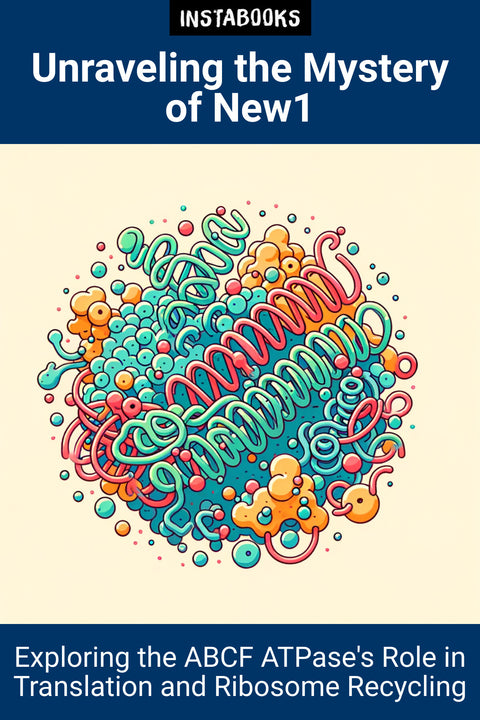
Unraveling the Mystery of New1
Exploring the ABCF ATPase's Role in Translation and Ribosome Recycling
Included:
✓ 200+ Page AI-Generated Book
✓ ePub eBook File — read on Kindle & Apple Books
✓ PDF Print File (Easy Printing)
✓ Word DOCX File (Easy Editing)
✓ Hi-Res Print-Ready Book Cover (No Logo Watermark)
✓ Full Commercial Use Rights — keep 100% of royalties
✓ Publish under your own Author Name
✓ Sell on Amazon KDP, IngramSpark, Lulu, Blurb & Gumroad to millions of readers worldwide
Introduction to the Wonders of New1
The ABCF ATPase New1 is a pivotal player in the translation termination and ribosome recycling processes within Saccharomyces cerevisiae. Recently, this enigmatic protein has transcended its previously opaque role thanks to groundbreaking research that has illuminated its mechanisms and functions. This book provides a deep dive into New1's integral contributions to cellular biology.
Mechanisms of New1's Action
Readers will explore the fascinating process of translation termination efficiency, which is influenced by stop codon context and identity. New1 interacts with ribosomes to resolve issues at the P site, particularly with tRNAArg and tRNALys isoacceptors. This section elucidates how New1 prevents ribosomal stalling, thereby maintaining a fluid translation process.
A Wealth of Experimental Evidence
The pages brim with insights from cutting-edge methods like 5'PSeq and cryo-EM, which have provided unprecedented visualizations of New1's interactions with ribosomes. The practical aspects of New1's rescue of ribosomal stalls are vividly captured through readthrough reporter assays, solidifying its role as a custodian of efficient translation termination.
Compensatory and Collaborative Functions
New1 not only facilitates ribosome recycling but also compensates for deficiencies in translational components like eEF3. This section highlights New1's dual function in elongation, fine-tuning translation to prevent cellular distress and preserve homeostasis.
The Road Ahead: Conclusion and Research Prospects
As the book concludes, readers are invited to envisage the future of New1 research and its implications for understanding human translation. This comprehensive exploration underscores New1's indispensability in cellular vitality and offers a launchpad for further academic inquiry.
Table of Contents
1. Introduction to Translation Termination in Yeast- Overview of Translation Termination
- Role of eRF1 and eRF3
- Importance of Efficient Process
2. Discovery of New1: A Curious Beginning
- Initial Observations of New1
- Cold Sensitivity and Growth Defects
- Ribosome Assembly Challenges
3. Unveiling New1's Mechanisms
- Ribosome Interaction Explored
- Structural Insights via Cryo-EM
- Resolving Translation Stalls
4. Role of New1 in Translation Termination
- Interaction with tRNA Isoacceptors
- Defect Resolution in P Site
- Mechanistic Studies and Findings
5. Experimental Approaches to Study New1
- 5'PSeq Techniques
- Cryo-EM Visualization
- Reporter Assays Reveal Insights
6. Compensatory Mechanisms of New1
- Ribosome Recycling Efficiency
- Compensation for eEF3 Deficiency
- Maintenance of Translation Elongation
7. Biological Implications of New1's Functions
- Cellular Homeostasis
- Impediments in Absence of New1
- Synthetic Biology Perspectives
8. Comparative Studies with Similar Proteins
- Other ABCF ATPases
- Cross-Species Comparisons
- Functional Analogies and Differences
9. Technological Advancements in Studying New1
- Cutting-edge Tools and Methods
- Evolution of Cryo-EM Techniques
- Integration with Genomic Studies
10. New1's Role in Yeast Cell Biology
- Importance in Cellular Processes
- Broader Impacts on Yeast Physiology
- Industrial Biotechnology Applications
11. Future Directions in New1 Research
- Unanswered Questions and Challenges
- Potential Human Applications
- Innovative Research Methodologies
12. Concluding Thoughts on New1
- Summary of Key Insights
- Reiterating New1's Importance
- Vision for Future Breakthroughs
Target Audience
This book is written for molecular biologists, geneticists, and students interested in translation mechanisms and protein synthesis in yeast.
Key Takeaways
- Insight into ABCF ATPase New1's role in ribosome recycling.
- Understanding translation termination and associated defects.
- Experimental methods like cryo-EM in studying protein functions.
- New1's compensatory function for eEF3 in translation elongation.
- Future directions for research in protein synthesis and translation.
